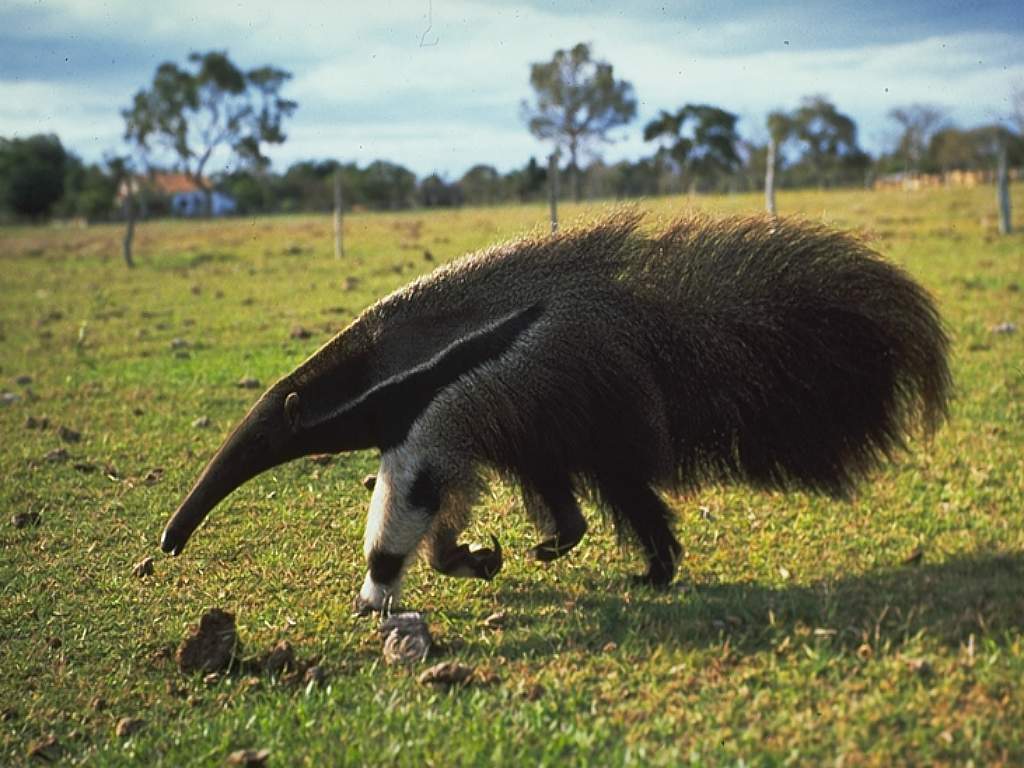
Giant anteater, or Ant bear(Myrmecophaga tridactyla)
Phylum —chordata
Class — mammalia
Order — pilosa
Family — myrmecophagidae
Genus – myrmecophaga
Appearance
The Giant anteater is the biggest of its family, 182 to 217 cm (5.97 to 7.12 ft) in length, with weights of 33 to 50 kg (73 to 110 lb) for males and 27 to 47 kg (60 to 104 lb) for females. It is recognizable by its elongated snout, bushy tail, long fore claws, and distinctively colored pelage.
Habitat
Area of their distribution covers Central and South America, stretching from Belize and Guatemala to northern parts of Argentina.
Behavior
Normally, Giant anteaters are diurnal animals. However, they can become nocturnal during specific weather conditions or living nearby human settlements. They usually sleep in abandoned burrows, hollows in the ground or areas with dense vegetation. Giant anteaters are solitary animals, except with mothers and their young. They are wandering animals, frequently moving from one spot to another. When they encounter each other in the wild, they can ignore each other, run away or even display antagonistic behavior. They use their forelimbs to fight, standing in a bipedal position and using the tail to keep balance. In spite of being terrestrial animal, the Giant anteater is an excellent swimmer. Also, though they don't tend to climb in the wild, they occasionally try to climb out of enclosures in captivity.
Diet
These animals are specialist carnivorous (insectivorous) predators, hunting on termites and ants. However, they can also consume soft bodied grubs, eggs as well as fruit.
Reproduction
They have polygynous mating system, where one male mates with more than one female. Breeding depends on region; they can breed either throughout the year or seasonally. Usually, the male and the female mate several times, remaining together for up to 3 days. Gestation period lasts 6 months, yielding a single baby. The pup is born with its full fur and markings, being fed from the mammary glands of its mother for about 6 months. Then, for about a year, the infant moves, riding on its mother's back, in spite of being able to gallop slowly. The youngster will stay with its mother for up to 2 years. Finally, at the time when the female becomes pregnant again, the pup leaves to begin its own life. Sexual maturity is reached at 2-4 years old.
In captivity
Giant anteaters have been known to live up to 25 years and 10 months in captivity.
Anteaters should be kept at home, as they are good-natured. They are absolutely not aggressive, they like to play with people. In addition, they love walking and do not resist walking on a leash. In general, there are no difficulties in keeping an anteater. Even a great artist like Salvador Dali kept a Giant anteater, which he took out for a walk on a leash.
The only thing they can bother their owners with is their huge claws, which can scratch various surfaces. To avoid this, you need to build an aviary or allocate an entire room with concrete walls.
Feeding anteaters, of course, has its own distinctive features, but does not cause much difficulty. If you can walk an anteater through the forest, then there he can find an anthill, and at home the anteater eats ground minced meat, eggs, rice, vegetables, fruits. You can also buy specialized food for insectivorous animals from us.
 Russian
Russian
 English
English
























